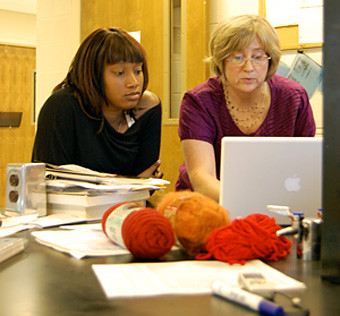It has been a cool summer at 51·çÁ÷, but students working in biology professor Nancy Pruitt’s lab were prepared with handmade hats and scarves after Pruitt introduced them to knitting.
Wendy Joo ’11 and Vickie Cadestin ’12 are on campus investigating whether proteins called dehydrins, produced by many plants to prevent dehydration, might also be produced in the animal kingdom, which has never been proven before.
Their research focuses primarily on the freeze-resistant larvae of the goldenrod gall fly.
“Freezing is a very dehydrating event,” said Pruitt, “so our hypothesis was that these freeze-tolerant insect larvae might also produce dehydrins.”
Preparing the larvae samples for analysis was a time-consuming process.
 |
| Biology professor Nancy Pruitt and Vickie Cadestin ’12 work in an Olin Hall lab. In addition to research skills, Pruitt taught Cadestin and Wendy Joo ’11 how to knit this summer, which they all did while waiting for experiment results. (Photo by Jason Kammerdiener ’10) |
“This kind of work involves, by necessity, a lot of waiting periods,” said Pruitt. The researchers filled that time working on a poster for their findings, discussing relevant papers, and knitting.
“You can knit and talk about the results you got in the last experiment,” said Pruitt.
Neither of the student researchers knew how to knit prior to learning from Pruitt, though both picked it up quickly.
“My friends laugh at me when I tell them I learned to knit this summer,” said Cadestin, “then they see what I’ve done and ask me to make them a hat!”
While knitting kept the atmosphere in the lab light, the research provided intriguing results.
“We got results that showed that the freeze-tolerant gall flies have dehydrin,” said Joo.
Further investigation revealed that the goldenrod plant from which the larvae were taken also contained dehydrin.
The researchers are confident that their findings are not a case of contamination, however, because the goldenrod dehydrin had a different molecular weight than that found in the larvae.
“It’s a different dehydrin,” said Joo.
The next step for Pruitt and her researchers, a process they have already begun, is to isolate the DNA sequence of the dehydrin gene.
They are also hoping to complete a couple scarves.